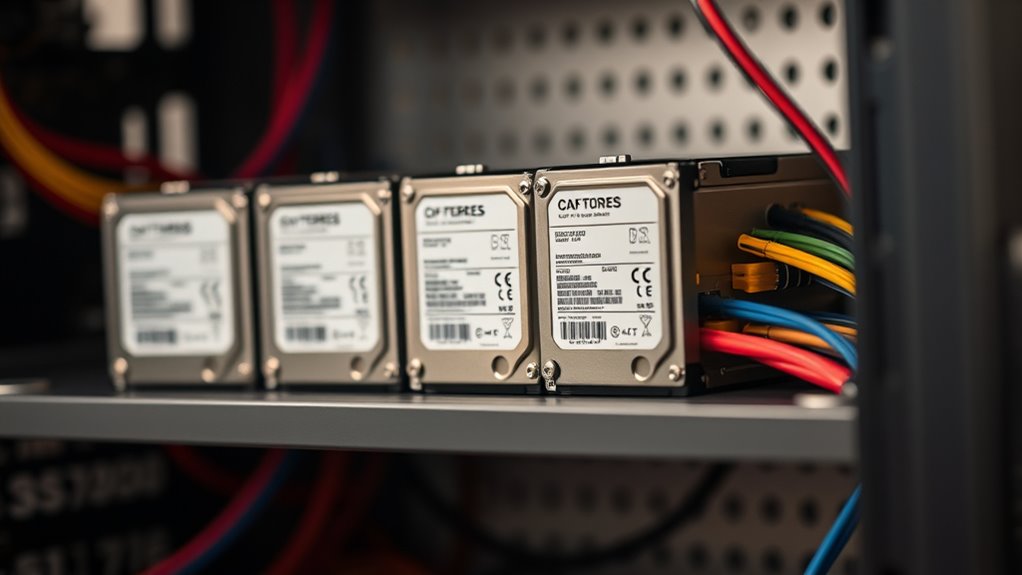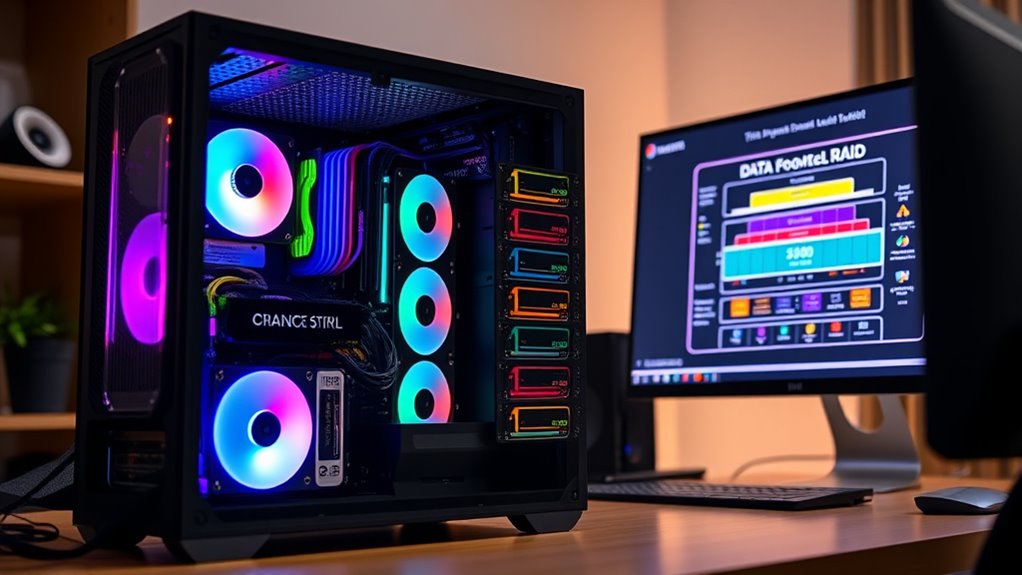RAID levels are ways to combine multiple drives to protect your data and improve performance at home. For example, RAID 1 mirrors your data, so if one drive fails, your info stays safe on the other. RAID 5 stripes data and adds parity, offering a good balance of speed and redundancy. RAID 10 combines mirroring and striping for high performance and strong protection. Keep exploring to understand which setup best fits your needs and how to set it up correctly.
Key Takeaways
- RAID combines multiple drives for improved performance, redundancy, or both, protecting data from drive failures.
- RAID 1 mirrors data on two drives, ensuring data availability if one drive fails.
- RAID 5 stripes data across multiple disks with parity, balancing speed and data safety.
- RAID 10 offers high performance and redundancy by combining mirroring and striping, requiring at least four drives.
- Regular backups are essential, as RAID helps prevent data loss but does not replace comprehensive data backup strategies.

RAID levels are different configurations that combine multiple hard drives to improve performance, data redundancy, or both. As a home user, understanding these levels helps you choose the right setup to protect your data and keep your system running smoothly. One of the main benefits of many RAID configurations is data redundancy, which means your data is stored in a way that allows you to recover it if a drive fails. This is especially important for safeguarding personal files, photos, and documents. When a drive fails in a RAID array with data redundancy, you don’t lose everything; instead, the system continues to operate, and you can replace the faulty drive without impacting your data. Having a solid grasp of data recovery techniques can further simplify restoring your data after hardware issues or accidental deletions.
Different RAID levels offer various methods of achieving data redundancy. For example, RAID 1 creates an exact mirror of your data across two drives. This means if one drive crashes, your data remains accessible on the other. It’s a straightforward way to protect critical files without complex setups. RAID 5, on the other hand, stripes data across three or more drives while storing parity information. Parity acts as a form of checksum, enabling data recovery techniques to rebuild data on a new drive if one fails. This configuration balances performance and redundancy, making it suitable for users who want both speed and safety. RAID 10 combines mirroring and striping, requiring at least four drives, and offers high performance along with redundancy. If any drive fails, your data stays safe, and the system continues to operate normally.
It’s essential to understand how data recovery techniques work in conjunction with RAID. When a drive fails in a RAID array, you typically replace the faulty drive and rebuild the array. During this process, the system uses parity information or mirrored data to restore the lost information. Many modern RAID controllers automate this recovery process, but it’s wise to have backups in place. RAID isn’t a substitute for regular backups — it’s a layer of protection that minimizes downtime and data loss. Additionally, AI security developments are influencing how data integrity is maintained across storage solutions. Having familiarized yourself with data redundancy concepts and recovery techniques helps you respond quickly if a drive failure occurs, avoiding major disruptions or data loss. By choosing the right RAID level for your needs and maintaining good backup habits, you can keep your home data safe, accessible, and protected against hardware failures.
Frequently Asked Questions
How Do I Choose the Best RAID Level for My Needs?
You should choose a RAID level based on your needs by weighing cost considerations and performance trade-offs. For example, RAID 0 offers high performance but no redundancy, so it’s suited for speed rather than safety. RAID 1 provides redundancy with a higher cost, while RAID 5 balances performance, redundancy, and cost. Consider how much data safety you need versus budget constraints, then pick the RAID level that best fits your priorities.
Can I Upgrade My RAID Configuration Later?
Yes, you can upgrade your RAID configuration later through RAID migration or adding hot spares. Migration allows you to change RAID levels without losing data, while hot spares automatically replace failed drives, maintaining redundancy. You actively plan for future growth, adapt your setup, and optimize performance. This flexibility helps you guarantee data safety, improve storage efficiency, and seamlessly evolve your system as your needs change.
What Are the Risks of Using RAID at Home?
Using RAID at home carries risks like data loss if you don’t regularly backup your important files. RAID protects against hardware failure but isn’t a substitute for backups. Power supply considerations are vital; unstable power can cause data corruption or drive failure. To minimize risks, make certain you have a reliable backup strategy and a stable power source, like an uninterruptible power supply (UPS), to safeguard your data and hardware.
Is Hardware or Software RAID Better for Beginners?
Like choosing a sturdy bridge or a fragile vine, hardware RAID often provides better performance benefits and reliability for beginners, making your data safer with less fuss. It’s a more straightforward, plug-and-play approach, though it might cost a bit more upfront. Software RAID, on the other hand, is budget-friendly and flexible but can be trickier to set up and potentially slower. If you’re new, hardware RAID usually feels like a safer, more robust path.
How Does RAID Impact Data Recovery in Case of Failure?
RAID improves data recovery by providing data redundancy, allowing you to restore files quickly after a drive fails. Depending on the RAID level, recovery speed varies; RAID 1 offers faster recovery since it mirrors data, while RAID 5 balances redundancy with slower rebuild times. By setting up RAID, you guarantee your data stays protected, reducing downtime and minimizing data loss during hardware failures.
Conclusion
Understanding RAID levels lets you balance risk and performance, giving you control over your data’s safety. Just like choosing between a sturdy lock and an open door, selecting the right RAID setup protects your files or exposes them. While RAID can safeguard your data, it’s not foolproof. So, think of RAID as your digital security guard—powerful yet fallible—reminding you that backups are still your best defense against data loss.









